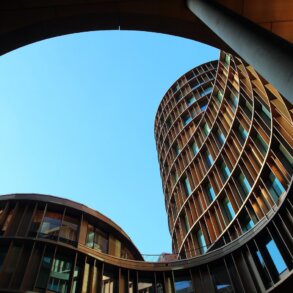By Armin Sieber and Ellen Even for Enlivening Edge Magazine
This article is part of a two-part article, and each part is understandable on its own, in either order. A more complete picture of the school requires reading both parts.
Introduction by Jean-Paul Munsch, Guest Editor of EE Magazine’s Education edition:
This Integral Day School, placed in the thriving city of Winterthur (Switzerland) is a fabulous example of integrating Teal thinking into practice. They developed a highly elaborated Teal culture over the years. And it shows how flexibly, yet rooted in a clearcut value base, the school operates. What a pleasure to see how creatively the elements of Spiral Dynamics are used to bring a sophisticated concept for a school into life, in order to let students emerge into their full human potential.
Is Teal able to deliver a comprehensive answer when we are asking for the best future-oriented school system?
The answer: It depends! Like in successful sailing where numerous environmental parameters, the characteristics of the ship, the fitness of the crew, the leadership qualities of the skipper—just to name a few factors—come together. The challenge lies in adaptively reacting to the circumstances and the ever-changing conditions while keeping a steady eye on the purpose of the journey.
Accordingly, there is no “best” school system, only systems that react in a more or less helpful, adaptive way to the present circumstances and the complexity therein.
At our school we started a sequence of fundamental steps by asking the question: What is the purpose of education?
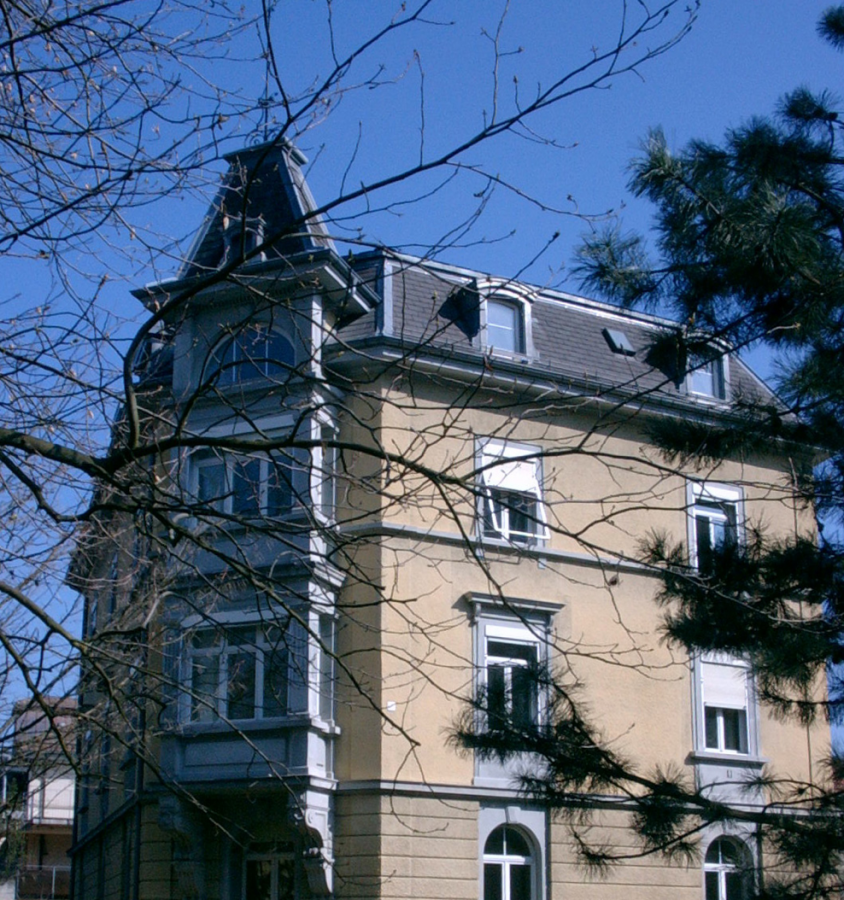
What follows is our actual answer, and we are already used to the fact that this is subject to change as change occurs within and around us: We design and build an environment where everyone—students, teachers, staff, parents—is encouraged and supported to take the next step in his or her personal path of growth.
In an increasingly complex world, we try to prepare our students for their future (and not for our past).
In this article we would like to share some of the core elements that we found helpful on our path.
The Trigon
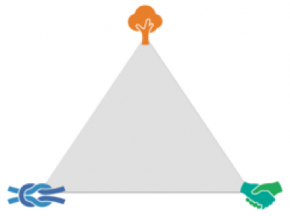 In order to bring Spiral Dynamics[1] consciousness forth throughout the school, we agreed on reducing the full format of SD to three stages: Blue, Orange, and Green. This way, we obtained a positioning and navigation tool for personal and institutional growth that could be easily applied even with students and parents. To apply this, of course, can only be done from within a Teal worldview/framework.
In order to bring Spiral Dynamics[1] consciousness forth throughout the school, we agreed on reducing the full format of SD to three stages: Blue, Orange, and Green. This way, we obtained a positioning and navigation tool for personal and institutional growth that could be easily applied even with students and parents. To apply this, of course, can only be done from within a Teal worldview/framework.
Beyond words, the three graphic symbols represent the levels in a comprehensible way.
With adults, it is quite easy to elucidate the substantial vMeme (worldview) shifts within the last 40 years by asking the question, “How did your parents ask you or how did you as a parent ask your children about school?”
- Blue: “Did you do what the teacher said?” “Have you been a good girl/boy at school today?”
- Orange: “Have you been successful in the test today?” “Was your grade above or below the class average?”
- Green: “Do you like going to school?” “Do you feel at ease in your class?”
For the first time in human history, we have up to three fundamental developmental shifts in the lifespan of one generation. Almost everyone can agree that appreciating this complex transition is not a question of which worldview is “right or wrong” but of how we can “include and transcend” these different values sets or worldviews?
Besides initial and ongoing training of all teachers and staff members, students and parents are introduced to the framework of Spiral Dynamics as well. This allows us, for example, to use the Trigon as a central piece in our one-on-one coaching with the students. Another application is to encourage students to explore the different perspectives of, for example, a dilemma, a historic event, or pending political questions, by using the far corners of the Trigon. And sometimes they end up intrigued to grasp the whole Spiral.
With the help of the Trigon, it is possible to position a whole school, a department, an administration, the school development process, etc., and start fruitful exchanges about balancing and including all three values stages according to the actual circumstances.
A Teacher’s Multiverse
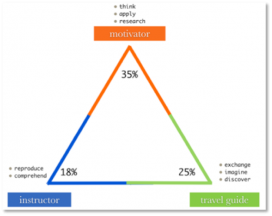 When teachers become familiar with the Trigon and its background, they can explore their own preferences of the different roles in teaching or learning, and start to expand or vary their roles according to the needs of the learners.
When teachers become familiar with the Trigon and its background, they can explore their own preferences of the different roles in teaching or learning, and start to expand or vary their roles according to the needs of the learners.
The percentage numbers represent a rough estimation of the actual vMeme spread of Blue, Orange and Green in Swiss population[2] and therefore the numbers do not sum up to 100%.
It seems obvious that Orange is numerically the most important part even though the parents’ longing for Green values and qualities in a school may be the primary motivation for choosing a private school like ours. After a while, some parents need reassurance that their child’s path forward is still bright and offering choices even though the culture of including and balancing Blue, Orange, and Green does not belong to their own field of experiences.
The parents’ professional work environment often relies heavily on Orange values so the school’s task is to find congruent, helpful answers for Orange needs. While the core elements of the collective Blue and Green form a firm framework for everyone involved in our school, the individual Orange goals can vary greatly depending on the individuality of each student.
While we use the color codes and terminology of SD[3] openly it is important to state that we keep reminding ourselves: SD is a helpful framework for describing and reflecting on important aspects of human development but it is not a means to put anyone in a colored drawer to reduce and simplify the richness of human complexity.
Orange Adaptivity
Trigon Dashboard
 From grades 4/5 upwards, students who are familiar with the SD symbols can use a Trigon-based dashboard to reflect on their personal progress, their needs, their strengths, or their actual goals. The pupils can evaluate their school-day in a moment. They can use the scales as a means for self-evaluation, as an opportunity to get feedback from a classmate or to give the teacher feedback.
From grades 4/5 upwards, students who are familiar with the SD symbols can use a Trigon-based dashboard to reflect on their personal progress, their needs, their strengths, or their actual goals. The pupils can evaluate their school-day in a moment. They can use the scales as a means for self-evaluation, as an opportunity to get feedback from a classmate or to give the teacher feedback.
It might seem of little importance, but in our experience the design of the scales as semi-circles can make an important difference when students have very high expectations. It seems natural that a positive range is 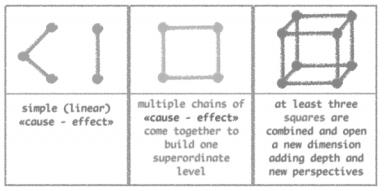 between 5 and 10 whereas a linear scale can imply that only a range between 8 and 10 is worth working for. The same perceptional effect applies for parents or teachers, too.
between 5 and 10 whereas a linear scale can imply that only a range between 8 and 10 is worth working for. The same perceptional effect applies for parents or teachers, too.
Students as Experts in Assessing
One aspect of preparing students for their future is nurturing their cognitive development.
With the help of a very simplistic tool, students can be introduced to assessing their own cognitive skills levels. The focus is not primarily on the accuracy of the assessment but on the activity of assessing itself and an open dialog within a group of students about similarities and differences in the assessments and the reasoning behind. The endeavor to facilitate cognitive development may primarily originate from Orange. The aspect of assessing answers in small groups and discussing the results with another group opens up to Green. Finally the combination of Green and Orange comes into play when the teacher asks something like: “Suppose you would like to improve your answering next time—with whom would you prefer to team up for the preparation?”
Student-Led Conference
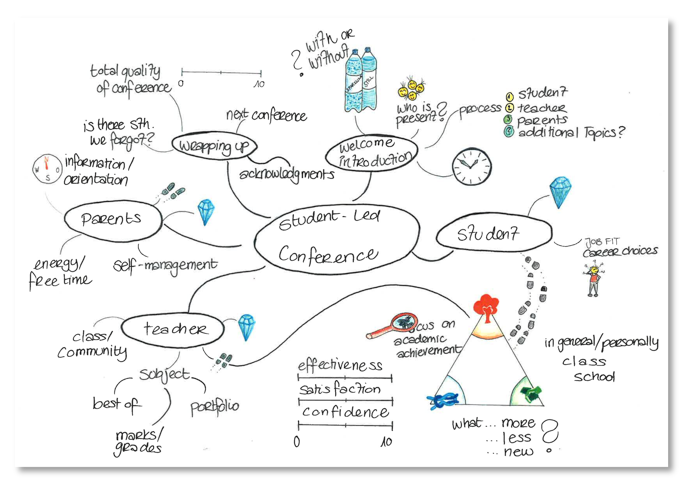 Twice a year, parents are invited for a conference to learn about the accomplishments and progress of their son/daughter. When they come for the first time, many of them enter the conference room a bit hesitantly because their former experience with school conferences may have been rather stressful.
Twice a year, parents are invited for a conference to learn about the accomplishments and progress of their son/daughter. When they come for the first time, many of them enter the conference room a bit hesitantly because their former experience with school conferences may have been rather stressful.
In our school students are coached and trained to be the “master of ceremony” (host of the conference) from the very beginning.
Starting with greeting the parents and offering a choice between sparkling or still water they lead through the whole conference. After presenting their own perspective including cognitive development and Trigon aspects, teachers and parents are invited to share their perceptions to complete the picture.
For parents operating mainly in Orange we offer orientation by referencing student achievements in regards to European or national standards (e.g. Common European Framework of Reference for Languages).
In correlation to these frameworks of reference we developed a rubric for self competence which allows students to visualize their progress in the three competence fields of the Trigon.
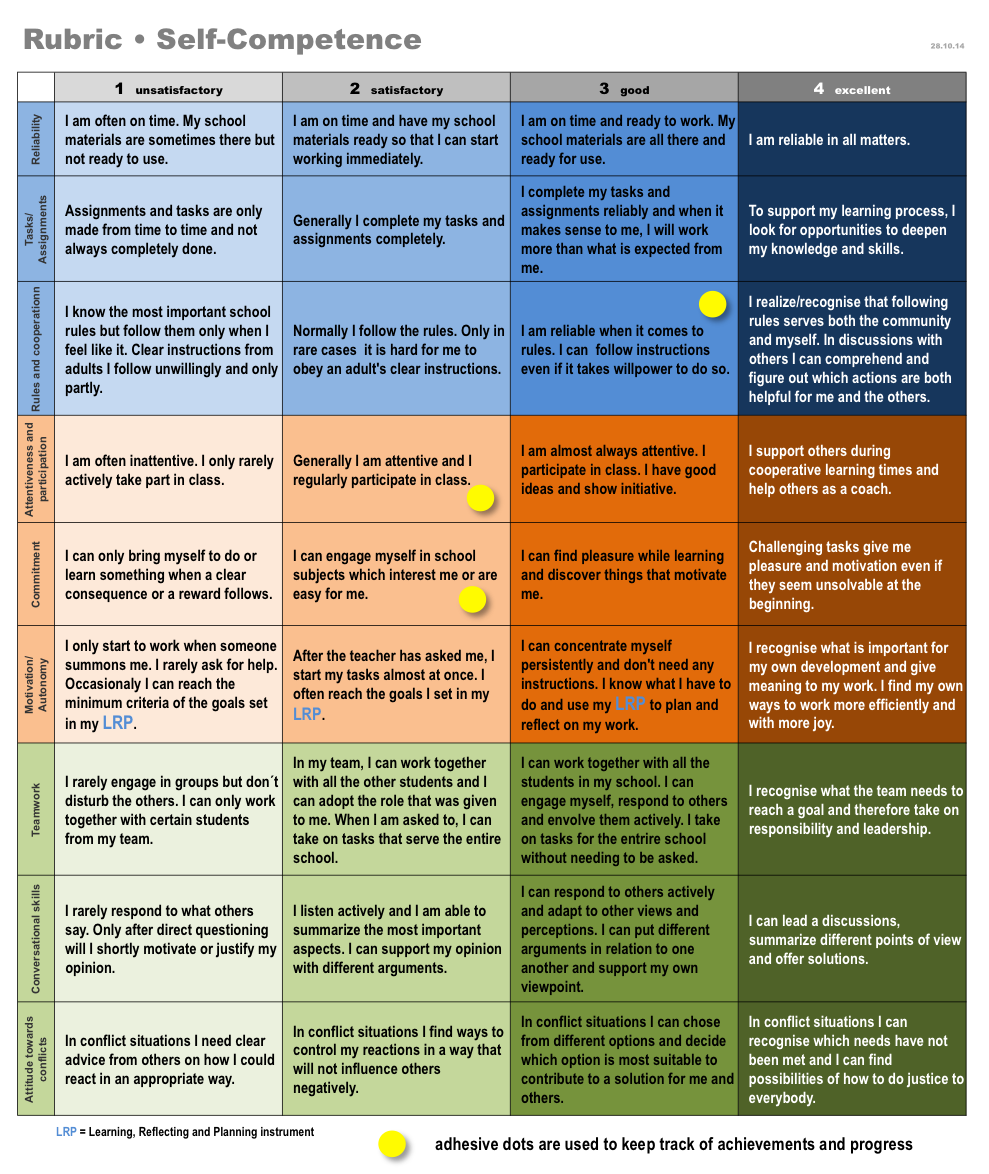 Blue Adaptivity
Blue Adaptivity
BlueChips—A Multi-Level Tool
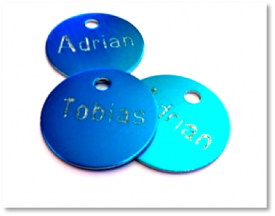 Whether the necessary framework to address Blue rules and values is already given or is the result of a collaborative democratic process, the potential positive power of a Blue framework resides in the ability to consequently enforce the rules from a stable and healthy Blue.
Whether the necessary framework to address Blue rules and values is already given or is the result of a collaborative democratic process, the potential positive power of a Blue framework resides in the ability to consequently enforce the rules from a stable and healthy Blue.
Our way to strengthen Blue qualities in students is to provide them with 4 aluminum roundels engraved with their name. They may keep them safe in their purse, their pencil case or on a keychain. Whenever they do something that contradicts important Blue agreements, they hand in one of these BlueChips.
If all four BlueChips are spent, the teacher fixes an appointment for 90 minutes of individual extra working time within the next 5 schooldays. The student decides autonomously what kind of school work he/she is doing during this extra time. After successful completion, the student is entitled to get back the 4 BlueChips—new game, new luck. There is no written record about how many times a student runs through this procedure.
At first glance, this approach may appear to be plain flatland/First Tier; so where does it become three-dimensional/Second Tier?
- The teacher clearly knows what to do when Blue agreements are not respected; the procedure helps to accept and assert healthy Blue.
- Students actually operating in Blue hand in their BlueChip on their own initiative; the procedure is in full Memetic resonance with their stage/worldview, meeting their need for fair and working consequences.
- Students operating mainly in Orange prefer to have their complete collection of BlueChips openly visible on a keychain, incidentally asking classmates whether they, too, didn’t have to hand in any BlueChip this term; they have an opportunity to make their positive learning/working attitude visible.
- Students in Red/Red-Blue operating mode might not voluntarily hand in a BlueChip at the very moment the instance occurs. Taking into account the student’s operating mode, the teacher quickly addresses what exactly was not in accordance with the rules and will get back to this student in a quiet moment or at the end of the lesson; no show-off event in front of the class. If this cooling time doesn’t work sufficiently, the teacher only states the student’s decision not to cooperate, without any further discussion, and hands over a written message to the person who is in charge of coaching this student.
This option is an important element to take pressure off of specialist subject teachers. These teachers rarely have the chance to establish sustainable personal relationships. Nevertheless, they are expected to enforce rules and procedures as well. If they can rely on the system’s ability to deal with Red/Red-Blue, these teachers may experience less disempowerment and paralyzing solitude and therefore, start to intervene more powerfully and more reliably. No more showdown-invitation-threats like, “If you … then I will …”. Only clear promises “You know that you are responsible for your decisions and you know the consequences. Whatever you decide, you can rely on me (and on this school). It’s your choice.”
In working with Red/Red-Blue transition phenomena, it is crucially important that there is a consequence, consistently. The severity of the consequence on the other hand is much less important. And, it is necessary that the consequence is applied immediately (e.g. Hand in the BlueChip) or within a narrow time-frame. Any accumulating records that will have an effect in a time further than a couple of days away risk missing the goal completely. Students themselves can keep track of important Blue successes on a record sheet (like handing in a substantial essay on time). Blue-Orange is triggered in students when they can win back BlueChips with a certain number of Blue success reports while achieving freedom from mandatory extra time.
Green Adaptivity
Pep-Talk Intervention
When students repeatedly show fundamental difficulties in respecting rules or completely refuse to cooperate, they have to make an appointment for an “intervention talk” with the headmaster. While we experimented with quite a number of 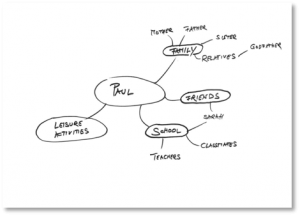 designs for these talks, we had to realize that our longing for Green values. especially in these moments, could be the root of the frustrating ineffectiveness. It seemed that the reason for failing to consistently change negative behaviour was not lack of insight or motivation, but a self-concept in urgent need of positive energy.
designs for these talks, we had to realize that our longing for Green values. especially in these moments, could be the root of the frustrating ineffectiveness. It seemed that the reason for failing to consistently change negative behaviour was not lack of insight or motivation, but a self-concept in urgent need of positive energy.
After the last SD-based redesign, the procedure of the talk is as follows:
1. The first part is strictly limited to a duration of 20 minutes. The student is asked to provide the necessary information to draw a mind-map with people 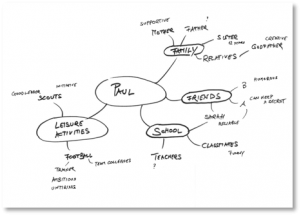 who know him/her well. The initial reason for the talk will not be addressed until step 4/5.
who know him/her well. The initial reason for the talk will not be addressed until step 4/5.
2.In a second step, students should tell which of her/his personal qualities are (supposedly) appreciated by the individuals in the network. This step is often a very hard one because students with multiple difficulties fitting into a school or family become themselves deficit-oriented and hardly hear genuine appreciation. The negative talk has overwhelmingly more weight. It might be that after 15 minutes only two qualities could be extracted on the mind-map. At this point it seems important that the adult leading the talk does not start to help and provide possible answers; instead she/he provides the mandatory next step of the process.
3.“Homework”: the student gets a copy of the mind-map and has to provide at least a total of 10 qualities within a week’s time by interviewing parents, friends, teachers, … and sometimes with the help of social media.
4.If the qualities are filled in, we let the student explain how she/he achieved the result and what might have been important in doing so. If a student does not succeed in filling in qualities, we make an appointment for a follow-up talk with at least two persons from the student’s network who support the finding of qualities as experts. Thus we share the responsibility and provide invitations to reflect on the basic communication with student.
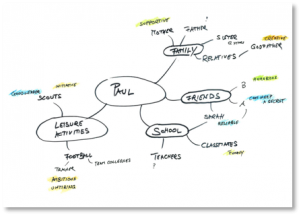 5.In the last step the student tries to answer these questions: Now, when you look at this mind-map with the qualities that others see in you, which of these qualities and which persons could support you to decide and react in a more helpful way the next time you encounter a similar situation (like the one that brought you here)? On a scale from 0 to 10, how high is your confidence that you will successfully master such a situation? Is that high enough to feel safe? (And if necessary. this is followed by exploring even the tiniest elements that would reinforce the confidence to succeed.)
5.In the last step the student tries to answer these questions: Now, when you look at this mind-map with the qualities that others see in you, which of these qualities and which persons could support you to decide and react in a more helpful way the next time you encounter a similar situation (like the one that brought you here)? On a scale from 0 to 10, how high is your confidence that you will successfully master such a situation? Is that high enough to feel safe? (And if necessary. this is followed by exploring even the tiniest elements that would reinforce the confidence to succeed.)
Walk your Teal talk
Education is an ideal and meaningful place to develop and train one’s abilities to deal with complexity.
The Tiniest Seed For Organizational Change
If the organizational maturity of a school can be assessed as Orange-Green/Green or heavy Green—as in our school some years ago—there is a high chance that decision-making procedures resemble grassroots democratic circles. While this is suitable for some teachers, Orange-centered teachers regret the absence of efficacy and Blue-centered teachers are longing for a headmaster’s clear guidance. To meet all needs, we decided to start a transformation process to become a sociocratic organization (http://www.sociocracy.info).
However, we found that this step was very ambitious with a risk of failure if we had not developed enough Yellow/Teal leadership. To start humbly we opted for an updated process in decision-making where Edward de Bono’s first tool of the CoRT thinking program[4] came in, preparing the ground for later developmental steps.
The “PMI” is a powerful thinking tool that is so simple it is almost unlearnable, because everyone thinks he or she uses it anyway. The letters are chosen to give a nicely pronounceable abbreviation so that we may ask ourselves, or others, to “do a PMI”.
- P stands for Plus or the positive points
- M stands for Minus or the negative points
- I stands for Interesting or the interesting points
In doing a PMI you deliberately direct the attention of the participants. It is done in a guided and disciplined manner over a period of about 2 to 4 minutes for every part.
Carrying out the process is quite easy. What is not easy is to direct attention deliberately in one direction after another when your prejudices have already decided for you what you should feel about an idea. It is this “will” to look in a direction that is so important.
Once this is achieved then the natural challenge to intelligence is to find as many P or M or I points as you can. So there is a switch. Instead of cognitive and/or emotional power being used to support a singular view point it is now used to explore the subject from different perspectives.
At the end of the exploration, emotions and feelings can be used to make a decision about a matter. The difference is that emotions are now applied after the exploration instead of being applied before when they would prevent exploration. (de Bono, 2004, p. 18 – 21)
The PMI resonates with Blue because of the clear structure and the built-in discipline elements, with Orange because of the highly efficient and intelligent use of time as well as the chance for innovative solutions and finally with Green because all participants can contribute equally, all voices are heard without valuation, and emotions are important and welcome.
After a very short introduction a PMI could be done even in groups of up to 40 people. Often times participants are amazed with the inherent collective ability to evaluate a matter profoundly even when it seemed to be highly controversial in the beginning. If intelligence is not used to defend a personal point of view but to openly explore as many aspects as possible participants experience each other’s wholeness and humaneness in a new light, and sometimes for the first time. PMI is easy to learn and easy to teach so teachers can introduce it in their classes to ignite new qualities in thinking as well.
PMI prepared the ground for decision-making procedures we are actually training with the sociocratic transformation of our school structure. When it comes to making decisions in the teachers’ circle, we don’t ask for acceptance or rejection. We check in on everyone with two questions: Is what we decide good enough for now? And is it safe enough to try?
These might also be relevant questions for starting your next sailing trip where you definitely command neither the winds nor the tide but you want to be open for new experiences and adventures. We hope our sharing can encourage others to set sails heading to Turquoise waters.
[1] https://www.dailyevolver.com/wp-content/uploads/2012/11/spiraldynamics.pdf
|http://www.integralworld.net/butters1.html
[2] estimate based on the results of wave 6 (2010 – 2014) http://www.worldvaluessurvey.org
[3] https://spiraldynamics.org/faq-basics/
[4] https://graemeallan.wordpress.com/2010/04/22/a-sample-cort-lesson-pmi/ |
 Armin Sieber: Throughout his different roles as teacher, headmaster, OD consultant, coach or trainer, facilitating personal or organizational growth is his great passion. Together with a team of highly committed teachers and staff members at Integrale Tagesschule Winterthur, Switzerland, he embarked on the journey to explore what future-oriented education might look like. [email protected] www.itw-oberstufe.ch www.integral-learning.ch
Armin Sieber: Throughout his different roles as teacher, headmaster, OD consultant, coach or trainer, facilitating personal or organizational growth is his great passion. Together with a team of highly committed teachers and staff members at Integrale Tagesschule Winterthur, Switzerland, he embarked on the journey to explore what future-oriented education might look like. [email protected] www.itw-oberstufe.ch www.integral-learning.ch
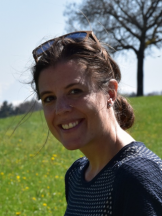 Ellen Even has lived in Belgium, Bahrain, and now Switzerland, and studied Educational Sciences and Culture and Development in Belgium, Sweden and Surinam. Looking for ways to integrate Non-violent Communication, Sociocracy, Solution-focused Therapy, and the Integral Theory into practice as a co-headmaster, teacher, and coach for adolescents and colleagues at ITW, one of her main intentions is a better understanding of what drives people, what makes them happy, and what helps them connect to and understand others. Her guiding question: “What could a world look like in which right and wrong lose their importance, and the focus changes towards what brings people together?” [email protected] www.itw-oberstufe.ch www.integral-learning.ch
Ellen Even has lived in Belgium, Bahrain, and now Switzerland, and studied Educational Sciences and Culture and Development in Belgium, Sweden and Surinam. Looking for ways to integrate Non-violent Communication, Sociocracy, Solution-focused Therapy, and the Integral Theory into practice as a co-headmaster, teacher, and coach for adolescents and colleagues at ITW, one of her main intentions is a better understanding of what drives people, what makes them happy, and what helps them connect to and understand others. Her guiding question: “What could a world look like in which right and wrong lose their importance, and the focus changes towards what brings people together?” [email protected] www.itw-oberstufe.ch www.integral-learning.ch


